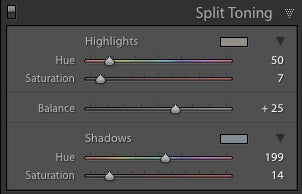- Lightroom Presets
- Mobile Presets
-
Photoshop
-
Learn
-
Support
-
Install
- Best Sellers
- Blog
By Lea Hartman on | No Comments

You love the look of your favorite presets, but have you ever looked under the hood to see how they are created? Lightroom is a masterful tool and its split toning panel is one of my favorite elements.
Here are the basics of split toning to get you started:
Split toning is located on the right hand side right underneath the HSL panel.
Note: The Split Toning Panel was recently upgraded and renamed. Its now called the Color Grading Panel, so if you see reference to color grading in your version of Lightroom instead of split toning, click on this link to read the appropriate tutorial. If you still see the Split Toning Panel, read on.
(Tip: right click on any of the panels and select "solo mode" if you prefer to open one panel at a time).

Split toning affects only two parts of your image: highlights and shadows.
In other words, you can place a higher emphasis on either highlights or shadows and determining the strength of the effect is as simple as playing with a few sliders.
(Tip: when playing around with various presets, use keyboard shortcut CTRL + N (PC) or CMD + N (MAC) to create a snapshot of your starting point and then you don't have to keep undoing edits or scrolling through the history panel).
In the example below, the left image is with split toning, the right image is without split toning enabled. (This image is edited with Marrakesh II from the Pretty Film Bohemian Collection). You can see how enabling the split toning (which is the preset's default state) reduces the warmth and redness slightly.

In this next example, I used Fiji preset from the Dark and Moody Collection. The left image is with split toning and the right image has the split toning disabled. The split toning here is used to warm the highlights and and shadows to give the image a nice glow.
In general, Pretty Presets uses the split toning panel in a very subtle way. The effects added here are generally soft and minimal. However, you can create over-the-top vintage effects with this panel as well.

Using split toning in Lightroom is easier than you think, I promise!
All you need to do is select your hue and then adjust the saturation slider to determine how strong you want the effect to be. You can also adjust the balance slider as mentioned above to determine the emphasis on either highlights or shadows. Give it a try!
(Tip: pressing the "\" key will show you a quick before image so you can see the difference your split toning adjustment just made).
Split toning is utilized in MANY presets as an added layer of customization. I personally prefer it obrt using the temperature slider in the basic panel because I really love how it targets specific areas of an image.
The next time you're applying your favorite preset, take a peek at the split toning panel and see how the magic works!
Do you have any questions or comments about Split Toning in Lightroom? Leave us a comment below - we would LOVE to hear from you. And PLEASE SHARE this post using the social sharing buttons (we really appreciate it)!




Lea is a self taught natural light photographer currently based out of North Carolina. Happily married for 14 years, she and her lover boy are raising three crazy kids wherever the army sends them. She's addicted to coffee, jamberry and her dog, Huxley.

Comments